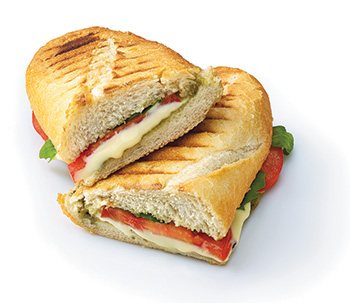Despite the name, panini machines or grills can be used for heating up more than just the popular hot sandwiches. Commercial-grade units, also known as sandwich presses, are slightly sturdier than the residential-grade types.
 Restaurants serving Mexican fare routinely use this equipment to heat up tortillas or make quesadillas. Others use it as a clamshell for melting cheese or preparing meat, such as burgers, steaks, chicken breasts and pork chops. Operators can also use the flat, griddle-type surface to prepare small portions of grilled vegetables or other stir-fry items. Some even use the machines with heavier platens as part of a micro griddle station in conjunction with a ventilation hood. It’s important to note that the thickness or density of the food will impact the cooking time.
Restaurants serving Mexican fare routinely use this equipment to heat up tortillas or make quesadillas. Others use it as a clamshell for melting cheese or preparing meat, such as burgers, steaks, chicken breasts and pork chops. Operators can also use the flat, griddle-type surface to prepare small portions of grilled vegetables or other stir-fry items. Some even use the machines with heavier platens as part of a micro griddle station in conjunction with a ventilation hood. It’s important to note that the thickness or density of the food will impact the cooking time.
The drawbacks with these units are the lack of durability with some types, the propensity for hinges and other moving parts to wear out, and the steep angle of some platens that tends to push sandwich contents out.
There are standard and heavy-duty machines available in both single and double sizes. Available widths generally range between 10 and 12 inches, with depths of 8 to 10 inches. The most popular panini machine sizes are 10 by 10 inches, 10 by 14 inches and 14 by 14 inches, although there are smaller and larger units available. Those larger than 14 by 14 inches are no longer manual as the reach is then too great for users to open and close the top plate. The small size makes this portable equipment versatile and ideal for small spaces.
These machines offer a choice of plate materials, each with advantages and disadvantages. Aluminum is the most affordable, heats up the quickest and transfers heat fast but requires more energy to stay hot. Cast-iron platens take longer to heat up but retain heat longer and provide good consistency. Both types of surfaces can be grooved, flat or a combination, depending on the application needs. Models with removable or Teflon platens are available and, although pricier, simplify cleaning.
With simple construction, the standard features of panini units are limited to a brush and scraper for cleaning, a thermostat for temperature monitoring and an on/off switch.
Some units have mechanical or electronic timers included, which allow operators to preset cooking times for different types of sandwiches. Although these devices monitor cooking time, they do not automatically adjust temperatures. The timers make it easier to cook on high heat fast to sear product or prepare food at lower temperatures longer to melt or heat all the way through the item.
The majority of panini machines are electric, either 1400 or 1800 watts and run on a standard 120-volt outlet. Units also are available that run on 220 volts. Infrared heat models are offered but not widely used.
 On some models, the spring tension for the platens can be adjusted as needed for the thickness of the sandwich or product. If more pressure is required for added heat and contact, the tension can be tightened. There are also higher-end models that open and close automatically.
On some models, the spring tension for the platens can be adjusted as needed for the thickness of the sandwich or product. If more pressure is required for added heat and contact, the tension can be tightened. There are also higher-end models that open and close automatically.
Operators should ensure the machine’s wiring is well protected as these units tend to get bumped and banged around. Wires that are compromised could lead to heating issues in the top of the clamshell.
Some models have a more free-floating top platen that stays level with the sandwich rather than one that sits at an angle and matches the sandwich shape, while others are more fixed and rigid. This preference will depend on the application and the operator. In either case, it’s key that the sandwich shape or food item is covered completely by the platens to cook consistently.
There are other types of panini machines that are less commonly used. The aforementioned infrared technology, which incorporates coated glass surfaces, heats fast to quickly penetrate food. Microwave panini machines also are available. These have a bigger base and utilize a microwave generator for heating food quickly. Combination infrared and microwave models also are available.










